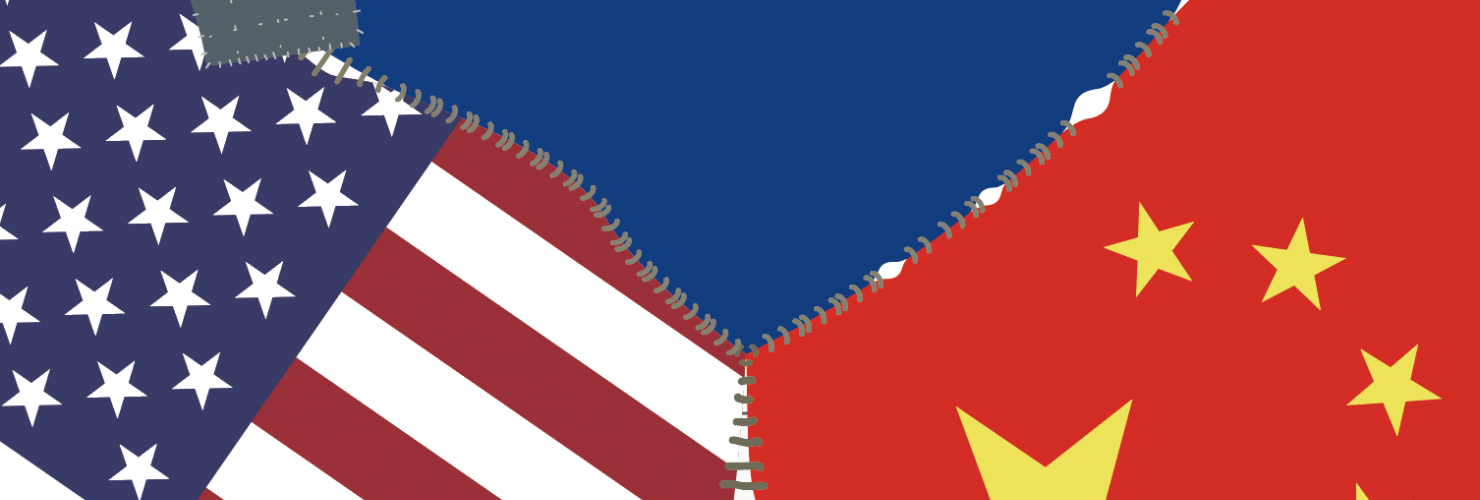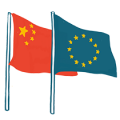

Decoupling - Severed Ties and Patchwork Globalisation
Report by European Chamber of Commerce in China in partnership with MERICS
The major report "Decoupling: Severed Ties and Patchwork Globalisation", released by the European Chamber in partnership with MERICS, measures the costs of decoupling for businesses operating in China.
The report was authored by Ester Cañada Amela, Tom Groot Haar, Jacob Gunter, and Carl Hayward from the European Chamber and Rebecca Arcesati, Mikko Huotari, John Lee, Caroline Meinhardt, and Max J. Zenglein from MERICS. The report finds that while the trade war has largely failed in its goal of forcing firms back to their home countries, the technology war is inflicting real damage on companies and economies alike. With decoupling dynamics showing no signs of reversing, solutions are quickly needed to deal with this new reality of ‘patchwork globalisation’.
Below you will find the executive summary of the report. You can also download the full report as a PDF.
Executive Summary
In the short interview below, Jörg Wuttke, President of the European Union Chamber of Commerce in China, and Mikko Huotari, MERICS Executive Director, introduce the main findings of the report.


The global COVID-19 pandemic turned 2020 into a year of uncertainty, individual suffering, economic disruption and heightened geopolitical tensions. While the roll-out of vaccinations has created something of a silver lining, the closing weeks of 2020 saw an acceleration of decoupling trends, pulling major economies further apart and disrupting commercial flows and other exchanges:
- The outgoing Trump Administration took another, maybe final, swipe at a major Chinese technology company: Semiconductor Manufacturing International Corporation (SMIC), China’s most advanced semiconductor firm, was blacklisted by the United States (US), effectively making them a ‘company non grata’ for global investors.
- Disputes between China and Australia led to a ban on Australian coal imports that has resulted in rolling power outages across various parts of China.
- China released measures to expand its national security review process for foreign investment.
Even the news that the European Union (EU)-China Comprehensive Agreement on Investment (CAI) had been concluded at the political level was met with significant scepticism across Europe, with many expressing doubts over the possibility of arriving at a fairer, more reciprocal EU-China economic relationship.
Meanwhile, China-based automotive manufacturers have been getting a taste of what disruptions to critical inputs like semiconductors can result in. Pandemic-related fluctuations in supply and demand have led to a shortage of certain semiconductors required for electronic control units (ECUs), which collectively form the ‘computer’ of a vehicle.1 As a result, manufacturers are shuttering much of their production until the shortage is corrected, which is expected to take up to nine months.2
To casual observers, such examples are part of a recent story that began in 2018, when the Trump Administration imposed the first round of tariffs on Chinese imports to the US. In reality, however, decoupling is a much longer-term trend that stretches back to the earliest days of China’s opening up and reform. Through market access and other barriers, China has long managed its interdependence with the world economy in a highly strategic and limited manner: selective coupling where it needed foreign technology or competition—such as in high-speed rail and the financial sector respectively—and remaining uncoupled in sectors reserved for China’s, often state-owned, national champions.
For more than 15 years, China’s leaders have also advanced extensive industrial policies in an attempt to develop self-reliance in critical technologies and seek dominance in high-value-added industries. The now infamous China Manufacturing 2025 (CM2025) initiative, which aims to substitute global competitors in ten strategic technologies, was just the most visible expression of a deeply engrained and extensive support system that protects China’s rising stars.
It is this blend of China’s conditional coupling, a vast state-aid apparatus and protectionism extended to national champions, and Beijing’s new-found self-confidence in its non-convergence with Organisation for Economic Co-operation and Development (OECD) norms and principles that is driving the current ‘crisis of interdependence’ with China. The Trump Administration may have provided the spark, but the powder keg China had created was bound to ignite eventually.
The future of globalisation with China is at stake
Things are now at a turning point. A Biden Administration will likely be less caustic and create fewer disruptions within the global economic order. But the massive shift in public opinion towards China, as well as a growing bipartisan consensus in Washington to consider China a strategic competitor on a divergent trajectory, means things are unlikely to result in ‘globalisation renewed’.
Unfortunately, China’s response to this ‘crisis of interdependence’ seems to be a redoubling of its drive to build self-reliance, and European companies in China report that this drive is different and more radical than in the past. As the December 2020 Central Economic Work Conference summaries noted, China’s top two priorities for 2021 are: 1) to build scientific and technological strength, with a call for a “new type of whole-of-nation system”;3 and 2) developing greater autonomy and control in industrial supply-chains. Any further market opening and deeper ‘coupling’ with China will therefore be conditional upon whether doing so supports these two goals.
The current impact of decoupling on European companies
Navigating the current and potential effects of this rapidly evolving reality is both complicated and distressing for European companies, particularly as they seek to expand their contribution and exposure to China’s post-COVID growth story. China’s long-standing non-coupling, combined with the growing chorus of countries committing to, or flirting with, active decoupling measures, is making this endeavour more complicated in a number of ways. This report identifies nine interrelated ‘layers’ of decoupling organised under four main categories that are impacting businesses to varying degrees:
- Macro decoupling – political and financial;
- Trade decoupling – supply chains and critical inputs;
- Innovation decoupling – research and development (R&D), and standards; and
- digital decoupling – data governance, network equipment and telecommunications services.
Underpinning the analysis of this study are European Chamber members’ reported experiences, expectations and impacts of decoupling trends. This information was gathered through a general survey, as well as several layer- specific surveys and scores of in-depth interviews. Following these exchanges, the concerns identified by members were categorised into three levels of urgency:
- Some of the most visible aspects of the decoupling story are only of moderate concern. The political dimension of global decoupling was identified as a dangerous catalyst for decoupling across the different layers but considered mostly manageable, apart from the growing impacts of human rights concerns on business in China. While deepening financial decoupling could lead to highly specific impacts for certain companies, the ‘nuclear’ options of direct confrontation or cutting China off from the US dollar (USD)-backed financial system were universally considered unlikely by companies interviewed for this report. Companies were generally resilient enough to endure most aspects of trade decoupling with only limited wounds being suffered, with multinational companies (MNCs) having adapted comparatively better than small and medium-sized enterprises (SMEs).
- Members recognised two emerging areas of divergence and decoupling that are of rapidly growing concern: standards and data. In non-contentious areas like machinery and chemicals, China’s standards are largely aligned with international ones. But in the areas that China has either labelled as strategic or in areas where its digital champions are world leaders, divergence in standards is ongoing. Meanwhile, the EU and China look likely to mutually decouple on the data front, with their different data-governance systems pushing an agenda of extensive data localisation requirements and erecting barriers to cross-border data transfer.
- Access to certain critical inputs is already a major concern for anyone with operations or even just supply chains in China. While most of the discussion about the ‘tech war’ has been limited to critical inputs like semiconductors, the effects of the conflict are actually far more pervasive. In order to calculate decoupling risks, companies need to urgently audit their own operations, as well as the operations of those up- and downstream of them, to identify critical bottlenecks that could be potentially targeted by either the US or China for strategic purposes. Digital decoupling is also having a sharp impact on companies, with telecommunications and network equipment manufacturers feeling increasingly squeezed out of the market. Most worryingly, information and communication technology (ICT) companies, and a growing number of firms across all industries, are unable to integrate their digital solutions in China, in large part due to market access barriers to the provision of both basic and value-added telecommunications services.
The present and future tech quagmire: preventing digital dilemmas, tech autarky and a weaponisation of interdependence
Taken in isolation, decoupling dynamics within each layer are causing at least some suffering to European companies, but when these layers intersect the pain becomes excruciating.
The picture painted by European Chamber members of the growing divergence in technology ecosystems can best be described as a quagmire. High-tech commercial flows are being ‘securitised’ at a growing pace. Direct market access barriers, like negative lists and national security measures, are increasingly joined by indirect ones, like national standards or licensing requirements, to prevent developing technology ecosystems in the US and China from overlapping.
Whether it’s the US’ Clean Network proposal or measures by Chinese authorities aimed at creating “autonomous and controllable” technology, it is all part of the same slippery slope: the technologies that are defining the future, and which are increasingly integrated into every sector of the economy, are being divided between two of the world’s three largest economies, each of which has a growing firewall separating itself from the other.
The US is moving towards a world in which Chinese technology should be purged from supply chains servicing Americans, while China is creating state-sponsored national champions to dominate a self-reliant ecosystem of indigenous technology integrated across its entire market.
The responses: uncharted, precarious and costly
As global supply chains are multi-tiered and heavily reliant upon a combination of leading technology from both the US and China, European companies that would like to integrate the best from both markets fear being forced to choose one of two strategies:
- dual systems: One supply chain and R&D system to exclusively serve China and one to provide for the rest of the world. For digital systems in China, this would necessitate either building an entire digital stack for the local market, or partnering with/outsourcing to Chinese providers.
- Flexible architecture: Everything that can be supplied in a ‘neutral’ manner in either market is developed and built for both systems, with other parts being developed separately for each market with the capability of being ‘swapped out’.
The costs of either option are considerable. Every step taken down the path of decoupling inflicts further damage on innovation, efficiency, cost-saving and economies of scale. Some companies, especially those for whom China represents a small share of global sales, admitted that, if left unchecked, decoupling could so imperil their economies of scale that they would be forced out of China altogether. Others, especially those with a higher proportion of global sales in China, would have to reorganise their company structures. In either case, this translates into lost investment and jobs, as well as higher costs and fewer choices for end-consumers.
As the world moves towards increasing techno-nationalism, the possibility of complete digital disintegration requires sober analysis as well as a responsible counter-vision for global integration.
For governments, this is about managing the intersection of partly incompatible economic models and conflicting geoeconomic strategies in a way that prevents further disruption of globalisation with China:
- Get to grips with the costs and implications of how your own and other governments’ actions shape decoupling trends, and work to find exit ramps, especially in areas where actions from one player intersect with and magnify those of another.
- Invest in pluri- and multilateral frameworks to regulate diverging digital worlds, and new and emerging technologies, with a special emphasis on maximising interoperability and connectivity across jurisdictions.
- Ensure that restrictions on foreign technology and investment in certain value chains is proportionate to the degree of security and privacy risks, and refrain from imposing restrictions on entire technology value-chains when only specific links generate risks.
In the meantime, European companies should buckle down, and prepare for the worst:
- Develop a corporate taskforce at headquarters (HQ), with designated counterparts in critical markets to jointly track emerging developments and share information to create a global strategy to mitigate decoupling effects.
- Map out the current and potential measures that would impact your company, both directly and indirectly (through suppliers/customers) across different jurisdictions, and prepare strategies to address all potential scenarios.
- Include in corporate strategy development the costs/benefits of the ‘dual systems’ and ‘flexible architecture’ strategies for managing the technology quagmire.
This is about more than just reactive and minor adjustments to temporary and erratic decoupling measures deployed by the Trump Administration or navigating China’s landscape of strategically-managed interdependence. It is about the joint responsibility of business and governments to make patchwork globalisation work for their citizens.
Macro decoupling
MERICS Chief Economist, Max J. Zenglein, and Policy and Communications Coordinator at the European Chamber, Tom Groot Haar, introduce the chapter on Macro decoupling in the short interview below.


Political
- The politicisation of business and geopolitical tensions are making the Chinese business environment increasingly difficult for foreign companies to navigate, and act as catalysts for decoupling in other areas.
- The current impacts on European companies in China include increasing risks due to a souring of public opinion in home markets towards China, a drop in business sentiment and uncertainty for operations due to the securitisation of business flows.
- The European business community in China is worried about the increased risk associated with ‘political reciprocity’ dynamics, and the potential for more unpredictable tit-for-tat exchanges of economic restrictions resulting from political/diplomatic tensions.
Financial
- In an effort to further reform its own financial system, China is actively working to integrate into the global financial system by establishing new investment channels into its capital markets and new opportunities for foreign financial institutions and investors.
- As long as China lacks a fully convertible capital account and an internationalised renminbi (RMB), its reliance on the USD remains its ‘Achilles heel’. Efforts to internationalise both its currency and financial markets are likely to accelerate, but liberalisation is needed to do so.
- Any broad restrictions on access to the USD would amount to a ‘nuclear option’ that would bring considerable economic damage to the US and the rest of the world. Only a massive escalation of political tensions seems likely to trigger it, as happened with Russia and Iran.
Trade decoupling
MERICS analyst, Caroline Meinhardt, and Senior Policy and Communications Manager at the European Chamber, Jacob Gunter, introduce into the chapter on trade decoupling in the short interview below.


Supply chains
- Supply chains were already changing considerably in China before either the COVID-19 pandemic or the trade war, with low-cost production moving elsewhere and most European companies expanding locally and further onshoring their supply chains.
- The trade war and pandemic were disruptive and expensive, but European MNCs proved resilient and made shifts in supply chains to outright avoid many tariffs and maintain operations in China during its COVID-19 recovery.
- Many European companies report a desire to further invest in China and onshore supply chains for the local market to avoid potential future disruptions, though enthusiasm varies by sector based on how welcome they feel in the market.
Critical inputs
- Targeted restrictions on the sale and export of critical goods—such as semiconductors, related manufacturing equipment, software or even rare earths—have become a more pressing concern for companies operating in China and globally.
- European companies have so far felt a limited direct impact due to export controls, but exposure is considerable for most. Pandemic-related shortages have shown how damaging lost or limited access can be, giving companies a taste of what the future may hold.
- Even companies with little to no risk may still be hit if their suppliers/customers can no longer source components or equipment from abroad. China’s new export controls increase risks as well, as locally-developed goods and solutions could be blocked from export.
Innovation decoupling
MERICS Analyst, Caroline Meinhardt, and Business Manager for European Affairs at the European Chamber, Ester Cañada Amela, talk about the issue of innovation decoupling in the short interview below.


R&D
- Although China is an increasingly attractive R&D destination, a number of issues—some long-standing and intensified by decoupling trends, others that have recently emerged as a result—constitute barriers to European companies’ R&D activities.
- In Europe, government stakeholders are re-considering their engagement with China on innovation cooperation, and the EU is working on tools to prevent unfair practices within its internal market.
- As a consequence, European businesses will encounter increased difficulties when developing both their global and China R&D strategies.
Standards
- While access to standardisation bodies in China has improved considerably in recent years, European companies—particularly in key sectors—still face informal barriers that prevent them from effectively engaging in standards-setting in China.
- These access issues become all the more relevant when considering China’s use of standardisation as a tool to advance its industrial and geopolitical agenda both at home and abroad.
- As a result, European companies may see their competitive edge being dulled and their market share reduced, while these standards-setting trends could also lead to distortion, or even fragmentation, of the global standardisation system.
Digital decoupling
MERICS analyst, Rebecca Arcesati, Senior Policy and Communications Manager at the European Chamber, Jacob Gunter, and MERICS Senior Analyst, John Lee, and discuss in this short interview below the state and implications of digital decoupling.
Data governance
- Data governance regimes in China and the EU already significantly restrict the transfer of data across the borders of these jurisdictions, creating significant compliance risks for companies.
- European companies anticipate that further restrictions on privacy and national security grounds will come into force soon, due in part to new legislation and judicial decisions in the EU, and further measures in China.
- As a result, it will be difficult and risky to exploit the potential of data pools across the EU’s and China’s
- jurisdictional boundaries, even as the importance of data as a tool for innovation and efficiency-building grows.
Network equipment
- US efforts to decouple from Chinese telecommunications and network equipment, and the scrutinisation of any China-originated links found in network value chains under its Clean Network programme are impacting European companies and their offerings in the US market.
- China’s rapidly expanding barriers to foreign telecommunications and network equipment value chains via requirements for “autonomous and controllable” technology is pushing European players out of the market or into niche roles.
- In combination, these dynamics are inadvertently forcing companies to consider firewalling their China and US network operations from one another, with their China operations relying more and more on local solutions and US ones being stripped of China-sourced inputs.
Telecommunications services
- China’s long-standing barriers to foreign telecommunications services and digital solutions has surged, especially with regard to the digital technology at the centre of the fourth industrial revolution, which includes value-added telecommunications services (VATS) like cloud and data centres.
- To offer their digital solutions, which increasingly come from traditional industries outside of ICT/ telecommunications, European companies are forced into joint ventures (JVs) with Chinese counterparts.
- As a result, European companies often have to integrate their products with locally-sourced digital solutions to serve local customers, which can result in the provision of suboptimal offerings that are not globally interoperable.
- Endnotes
-
1 Zhang, Fanny, China auto industry recovery faces challenges from Europe chip shortage, ICIS, 9th December 2020, viewed 22nd December 2020, <https://www.icis.com/explore/ resources/news/2020/12/09/10584052/china-auto-industry-recovery-faces-challenges-from-europe-chip-shortage>
2 Semiconductor bottlenecks hit auto sector, VW, suppliers warn, Automotive News, 4th December 2020, viewed 22nd December 2020, <https://www.autonews.com/china/ semiconductor-bottlenecks-hit-auto-sector-vw-suppliers-warn>
3 The Central Economic Work Conference was held in Beijing, Xi Jinping and Li Keqiang delivered important speeches, Xinhua, 18th December 2020, viewed 21st December 2020,
<http://www.xinhuanet.com/politics/leaders/2020-12/18/c_1126879325.htm>



